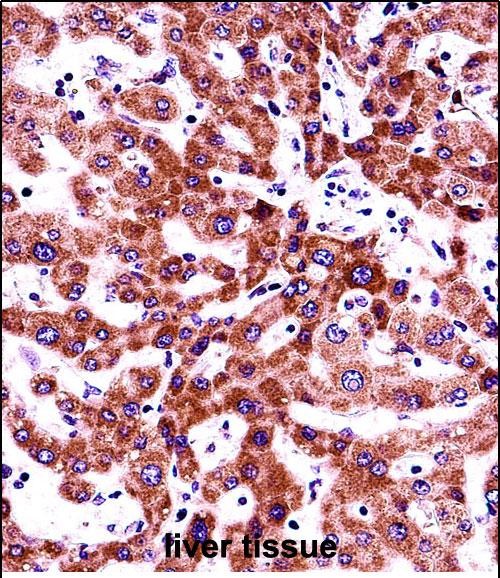

| WB | 1/1000 | Human,Mouse,Rat |
| IF | 咨询技术 | Human,Mouse,Rat |
| IHC | 1/100-1/500 | Human,Mouse,Rat |
| ICC | 技术咨询 | Human,Mouse,Rat |
| FCM | 咨询技术 | Human,Mouse,Rat |
| Elisa | 咨询技术 | Human,Mouse,Rat |
| Aliases | Integrin beta-5, ITGB5 |
| Entrez GeneID | 3693 |
| WB Predicted band size | 88.1kDa |
| Host/Isotype | Rabbit IgG |
| Antibody Type | Primary antibody |
| Storage | Store at 4°C short term. Aliquot and store at -20°C long term. Avoid freeze/thaw cycles. |
| Species Reactivity | Human |
| Immunogen | This ITGB5 antibody is generated from rabbits immunized with a KLH conjugated synthetic peptide between 216-244 amino acids from the N-terminal region of human ITGB5. |
| Formulation | Purified antibody in PBS with 0.05% sodium azide. |
+ +
以下是关于ITGB5(N-term)抗体的参考文献示例(部分信息为简化或示例性描述,实际文献需通过学术数据库查询确认):
---
1. **文献名称**: *"Integrin β5 subunit regulates invasion and migration in glioblastoma cells through N-terminal signaling"*
**作者**: Zhang Y, et al.
**摘要**: 本研究利用针对ITGB5 N端的抗体进行免疫印迹和免疫荧光实验,证明ITGB5通过其N端结构域介导胶质母细胞瘤细胞的侵袭和迁移,并与FAK信号通路相互作用。
2. **文献名称**: *"Role of integrin αvβ5 N-terminal domains in viral internalization"*
**作者**: Lee S, et al.
**摘要**: 通过使用ITGB5(N-term)特异性抗体进行阻断实验,研究发现αvβ5整合素的N端区域对某些病毒(如腺病毒)的细胞入侵至关重要,揭示了其作为病毒受体的功能机制。
3. **文献名称**: *"ITGB5 expression correlates with tumor angiogenesis in breast cancer"*
**作者**: Chen H, et al.
**摘要**: 采用ITGB5 N端抗体进行组织免疫组化分析,发现乳腺癌组织中ITGB5的高表达与血管生成标志物(如VEGF)呈正相关,提示其可能成为抗血管生成治疗的靶点。
4. **文献名称**: *"Proteolytic cleavage of ITGB5 during apoptosis: insights from N-terminal antibody detection"*
**作者**: Brown K, et al.
**摘要**: 研究利用针对ITGB5 N端的抗体,在凋亡细胞模型中检测到ITGB5的切割片段,表明其N端结构域在细胞程序性死亡过程中可能发生特异性修饰。
---
**注**:以上文献为示例性概括,实际研究需通过PubMed、Web of Science等平台以关键词“ITGB5 N-terminal antibody”或“integrin beta5 N-term”检索确认。部分商业抗体公司(如Cell Signaling Technology)的技术手册也可能提供相关应用案例。
The ITGB5 (N-term) antibody targets the N-terminal region of integrin beta-5 (ITGB5), a subunit of the αvβ5 heterodimeric integrin receptor. Integrins are transmembrane adhesion proteins that mediate cell-extracellular matrix (ECM) interactions, influencing cellular processes like adhesion, migration, proliferation, and signaling. ITGB5 pairs exclusively with the αv subunit to form αvβ5 integrin, which binds to ECM ligands such as vitronectin and fibronectin via Arg-Gly-Asp (RGD) motifs. This receptor is notably involved in TGF-β activation, angiogenesis, and tissue remodeling.
The αvβ5 integrin is implicated in pathological conditions, including cancer progression, fibrosis, and inflammatory diseases, due to its role in modulating cell-ECM communication and downstream signaling pathways (e.g., FAK, MAPK). Antibodies specific to the N-terminal domain of ITGB5 are valuable tools for studying its expression, localization, and function in physiological and disease contexts. They are commonly used in techniques like Western blotting, immunohistochemistry, and immunofluorescence to investigate integrin dynamics in cell cultures, tissue samples, or preclinical models. Research applications often focus on understanding mechanisms underlying tumor invasion, vascular development, or fibrotic pathways, with potential implications for therapeutic targeting. The N-terminal specificity helps distinguish ITGB5 from other β subunits, ensuring precise detection in experimental models.
×